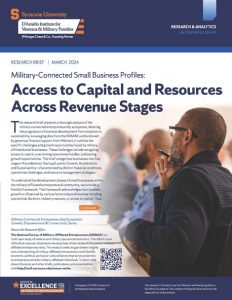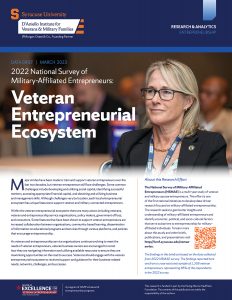This research brief presents a thorough analysis of the military-connected entrepreneurship ecosystem, detailing the progression of business development from inception to sustainability. Leveraging data from the NSMAE and bolstered by generous financial support from Walmart, it outlines the specific challenges and growth opportunities faced by military-affiliated small businesses. These challenges include navigating access to capital, overcoming operational hurdles, and seizing growth opportunities. This brief categorizes businesses into five stages—Foundational, Startup/Launch, Growth, Acceleration, and Sustainability—characterized by distinct financial conditions, operational challenges, and resource management strategies.
It is important to note the complexity and non-linearity of business development stages. Business stages are not always sequential or discrete, and companies may operate across multiple stages concurrently, especially when exploring new products, services, or undergoing operational modifications. This variability underscores the dynamic nature of business growth, influenced by years in operation, industry context, access to capital, and other critical factors. Our categorization, informed by data focusing on military-affiliated entrepreneurship, uses revenue breakpoints as flexible guidelines to capture these nuances, aiming to provide a nuanced understanding of business development that reflects the unique paths companies may take in their growth journeys.
Key Highlights By Business Stage
Foundational Stage
(Ideation and Development Phase): Revenue Range: Loss – $0.
However, 77% are not yet earning revenue
from clients requiring certification.
The demographic profile shows a diverse participation, with significant representation from Black/African American (39%) and Hispanic or Latino/a/x (4.8%) communities.
Industry Trend: The top three industries are professional, scientific, technical services
Startup/Launch Stage
(Market Entry Phase): Revenue Range: $1 – $250,000
On average, when businesses enter the market they have four employees.
Funding comes from a mix of personal savings and early-stage venture capital.
Industry trend: The industry distribution remains broad, with an increase in construction and retail trade.
Growth Stage
(Expansion Phase): Revenue Range: $250,000 – $1 million
On average, when businesses enter the market they have six employees signaling further organizational development.
Funding includes more strategic funding sources, including Series A/B funding.
Industry trend: increases in construction and professional services, in both traditional and knowledge-based sectors
Acceleration Stage
(Expansion Phase): Revenue Range: $250,000 – $1 million
On average, when businesses enter the market they have 20 employees indicating substantial organizational growth.
Funding includes venture capital and strategic funding.
Industry trend: shift toward professional, scientific, and technical services in high-value, expertise-driven markets
Notable increase in proportion of businesses located in large metropolitian areas.
Sustainability Stage
(Growth and Sustainability Phase): Revenue Range: Over $5 million
On average, when businesses enter the market they have 184 employees.
Industry trend: shift toward professional services, with an expanding footprint in construction and wholesale trade.

Download the full brief to read a deeper profile, examining business motivations, demographics, networking and resources, and information about funding and debt at each revenue stage.




